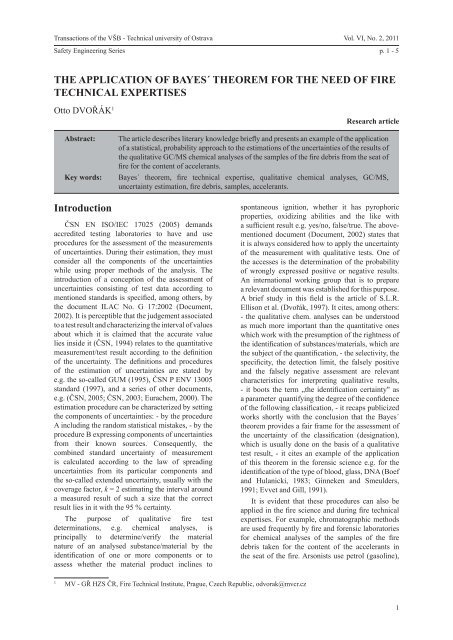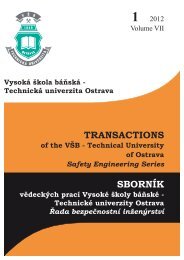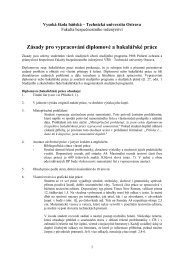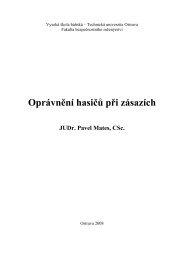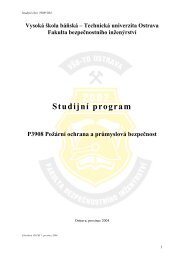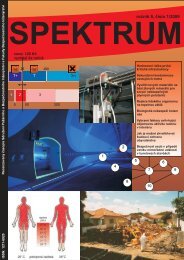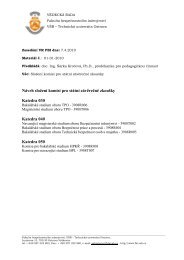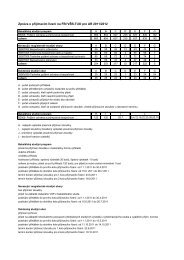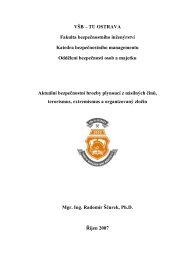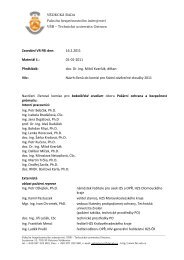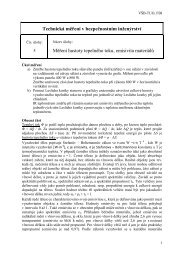Transactions - FBI - Vysoká Å¡kola báÅská - Technická univerzita ...
Transactions - FBI - Vysoká Å¡kola báÅská - Technická univerzita ...
Transactions - FBI - Vysoká Å¡kola báÅská - Technická univerzita ...
You also want an ePaper? Increase the reach of your titles
YUMPU automatically turns print PDFs into web optimized ePapers that Google loves.
<strong>Transactions</strong> of the VŠB - Technical university of OstravaSafety Engineering SeriesVol. VI, No. 2, 2011p. 1 - 5THE APPLICATION OF BAYES´ THEOREM FOR THE NEED OF FIRETECHNICAL EXPERTISESOtto DVOŘÁK 1Abstract:Key words:Research articleThe article describes literary knowledge briefly and presents an example of the applicationof a statistical, probability approach to the estimations of the uncertainties of the results ofthe qualitative GC/MS chemical analyses of the samples of the fire debris from the seat offire for the content of accelerants.Bayes´ theorem, fire technical expertise, qualitative chemical analyses, GC/MS,uncertainty estimation, fire debris, samples, accelerants.IntroductionČSN EN ISO/IEC 17025 (2005) demandsaccredited testing laboratories to have and useprocedures for the assessment of the measurementsof uncertainties. During their estimation, they mustconsider all the components of the uncertaintieswhile using proper methods of the analysis. Theintroduction of a conception of the assessment ofuncertainties consisting of test data according tomentioned standards is specified, among others, bythe document ILAC No. G 17:2002 (Document,2002). It is perceptible that the judgement associatedto a test result and characterizing the interval of valuesabout which it is claimed that the accurate valuelies inside it (ČSN, 1994) relates to the quantitativemeasurement/test result according to the definitionof the uncertainty. The definitions and proceduresof the estimation of uncertainties are stated bye.g. the so-called GUM (1995), ČSN P ENV 13005standard (1997), and a series of other documents,e.g. (ČSN, 2005; ČSN, 2003; Eurachem, 2000). Theestimation procedure can be characterized by settingthe components of uncertainties: - by the procedureA including the random statistical mistakes, - by theprocedure B expressing components of uncertaintiesfrom their known sources. Consequently, thecombined standard uncertainty of measurementis calculated according to the law of spreadinguncertainties from its particular components andthe so-called extended uncertainty, usually with thecoverage factor, k = 2 estimating the interval arounda measured result of such a size that the correctresult lies in it with the 95 % certainty.The purpose of qualitative fire testdeterminations, e.g. chemical analyses, isprincipally to determine/verify the materialnature of an analysed substance/material by theidentification of one or more components or toassess whether the material product inclines tospontaneous ignition, whether it has pyrophoricproperties, oxidizing abilities and the like witha sufficient result e.g. yes/no, false/true. The abovementioneddocument (Document, 2002) states thatit is always considered how to apply the uncertaintyof the measurement with qualitative tests. One ofthe accesses is the determination of the probabilityof wrongly expressed positive or negative results.An international working group that is to preparea relevant document was established for this purpose.A brief study in this field is the article of S.L.R.Ellison et al. (Dvořák, 1997). It cites, among others:- the qualitative chem. analyses can be understoodas much more important than the quantitative oneswhich work with the presumption of the rightness ofthe identification of substances/materials, which arethe subject of the quantification, - the selectivity, thespecificity, the detection limit, the falsely positiveand the falsely negative assessment are relevantcharacteristics for interpreting qualitative results,- it boots the term „the identification certainty" asa parameter quantifying the degree of the confidenceof the following classification, - it recaps publicizedworks shortly with the conclusion that the Bayes΄theorem provides a fair frame for the assessment ofthe uncertainty of the classification (designation),which is usually done on the basis of a qualitativetest result, - it cites an example of the applicationof this theorem in the forensic science e.g. for theidentification of the type of blood, glass, DNA (Boefand Hulanicki, 1983; Ginneken and Smeulders,1991; Evvet and Gill, 1991).It is evident that these procedures can also beapplied in the fire science and during fire technicalexpertises. For example, chromatographic methodsare used frequently by fire and forensic laboratoriesfor chemical analyses of the samples of the firedebris taken for the content of the accelerants inthe seat of the fire. Arsonists use petrol (gasoline),1MV - GŘ HZS ČR, Fire Technical Institute, Prague, Czech Republic, odvorak@mvcr.cz1


